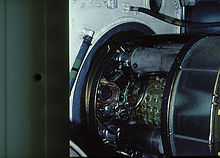Vosper class
The Vosper class ( class 153 ) consisted of two British- made speedboats with gas turbine propulsion, which the German Navy operated for testing from 1962 to 1965.
Service history
The German Navy bought the two for trial in 1962 MTB type Brave with gas turbine drive at the British shipyard Vosper & Company . The Brave Ferocity type had two gas turbines and the Brave Borderer type had three turbines. They drove under the NATO IDs P 6193 ( arrow ) and P 6194 ( beam ) and, although they were not structurally identical, were listed as a class under the number 153.
The Schnellboot Pfeil (P 6193) was in service from June 27, 1962 to September 30, 1965. The namesake for the speedboat were the gunboat Pfeil (1860–1871) and the Aviso Pfeil (1882–1918). The Strahl (P 6194) was in service from November 2, 1962 to September 30, 1965. They were assigned to the 1st Schnellbootgeschwader and were used primarily in the Baltic Sea , at times also for test drives for new weapon systems.
After the end of the tests and the result that boats of this type did not meet the needs of the Navy, the boats were sold to Greece and were there under the names Aiolos and Astrapi in service.
Technical data arrow
- Length: 27.60 m
- Width: 7.30 m
- Draft: 2.00 m
- Displacement: 75/85 tons maximum
- Drive: 2 × Bristol Proteus gas turbines , 4,260 hp each at 11,000 rpm, 2 screws 36 inches in diameter
- Power supply: 2 × Rover gas turbines 50 HP
- Speed: up to approx. 50 kn (depending on armament and weather conditions)
- Fuel: 20,600 liters of diesel
- Consumption: 2,500 l / h at full load
Technical data beam
The sister boat Strahl differed from Pfeil in size and drive power, and the superstructure was also slightly modified
- Drive: three Bristol Proteus gas turbines on three screws, otherwise like arrow.
- Length: 30.30 m
- Width: 8.00 m
- Draft: 1.80 m
- Displacement: 96.5 / 101.60 tons
Propulsion system
The built-in gas turbines were Bristol Proteus aircraft propeller turbines . In addition to the gearbox attached to the engine, a V-gearbox was also attached to achieve the required propeller speed. Total reduction = 6.44. The turbines were started with air from the e-turbines. As salt particles were sucked in with the combustion air, a total of around 27 m³ / s, the engines had to be cleaned at the end of each journey by pumping in petroleum and then distilled water. The performance was strongly dependent on the outside temperature, the colder, the higher.
The propellers were 36 inches in diameter and 48 inches in pitch. Since the propeller blades were bent at the beginning by accelerating too quickly, and thus a loss of speed, locks were built into the control levers to prevent accelerating too quickly.
The turbine exhaust pipes with a diameter of 80 cm were located at the stern. These were closed with flaps in the port. Long exhaust flames formed when the turbines were started. By introducing fuel into the hot exhaust gases, a smoke screen could be created for camouflage.
construction
The fuselage was made of composite construction with 18 mm wooden planking on light metal frames. The hull was reinforced with plastic below the waterline. The hull was divided into eight watertight compartments. The boats were so-called gliders with knickspanten , so the handling characteristics in rough seas were very hard.
The superstructures were made of light metal and some of them were riveted. In the superstructures there was a closed and above it an open control stand. The entire machine monitoring system was built into the closed bridge; it largely resembled the instrumentation in aircraft.
The air intake duct for the turbines was located behind the bridge superstructure, and there was an adjustable trim tab at the rear.
Armament
- Arrow 2 × 40 mm Bofors rapid fire cannon and four torpedoes in drop racks.
- Beam 1 × 40 mm Bofors rapid-fire cannon and four torpedoes in launching racks.
crew
- 2 officers, commander and IWO
- 3 boatmen, chief machinist, engine master and nautical No. 1
- 4 mates, radio, seamanship, electrical and machine
- 11 team ranks
Floor plan
- Section I - steering gear room
- Section II - turbine room
- Section III - gear room with e-turbines and engine monitoring
- Section IV - fuel tank
- Section V - Commanders' Chamber, Operations Center , Radio Room and E-Center
- Section VI - galley and boatswain's chamber
- Section VII - team and Uffz living room
- Section VIII - Collision Area
References
literature
- Köhler's fleet calendar 1965 - 53rd year. Wilhelm Köhler Verlag, Minden (Westphalia) 1965.
- H. Peter Bunks. The "ray" shines. Memory of an extraordinary time. In: Marineforum 1 / 2-2011, p. 56 ff.
Web links
- Brave general (Engl.) ( Memento of 29 September 2007 at the Internet Archive )
- Brave borderer at Powerboat trust
- Brave Ferocity at the Powerboat trust









